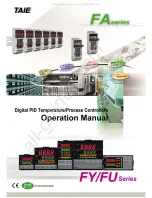
Powered by Safety
®
31
01.4IB.46300
Installation
l. M
otor
c
onnections
Motor lead cables may enter or terminate from
either the top or the bottom access openings
of the vertical section. The load terminals are
located behind the low voltage compartment.
Access the load terminals through the front of
the 400A two high, vertical section
or the front of the 800A vertical section
. After motor cables are
terminated, insulating boots must be installed
on the load terminals.
Note:
Refer to site-specific project drawings
for recommended and available
conduit space for top or bottom
access.
As an option, barriers may be installed
so that the load cables between two
vacuum contactors are isolated in the
same vertical section.
M. p
ower
c
aBle
t
erMination
Cables should be prepared for termination in
accordance with the instructions of the cable
manufacturer. However, the following general
recommendations are given for proper cable
termination in equipment.
1. Pull in the cables in accordance with the
equipment outline diagram specifications.
Position the cables for maximum clearance
between the phases, ground, and other
cables, or wire runs. Refer to the specific
job drawings and this instruction bulletin
for the recommended location for the
incoming cables.
2. Prepare the cable for termination in
accordance with the manufacturer’s
instructions.
3. Bolt the cable terminals to the bus or other
point of termination.
4. If contact between the cable and an
adjacent bus cannot be avoided, tape the
bus in the immediate vicinity of the cable
contact point so that the surface creepage
distance from the cable to the bare bus bar
is at least three inches. Thus, the surface
creepage from the bare bus where the
cable terminates, to the bare part of the bus
where the cable touches, will be a distance
of at least seven inches. The thickness of
tape on the bus should be approximately
5/32".
5. Terminate any ground return and cable
shield drains to the compartment ground
bus.
6. Run all the low voltage wires so as to avoid
any possible contact with high voltage
lines.
Before any primary cable connections are
made, the cables should be identified to
indicate their phase relationship with the
switchgear connections. This is necessary to
ensure that motors will rotate in the proper
direction and that the phase rotation is the
same when interconnecting two different
sources of power.
Normally, compression terminals are used
to terminate primary cables. When shielded
cables are used, proper stress relief must
be provided at the cable termination. This
may be done by the use of a commercially
available cable terminator, many types of
which are available, or by the use of a
stress cone, which can be either
hand-built or the prepackaged type.
In all cases, carefully follow the cable
manufacturer’s recommendations for
installation of the type of cable being
used. Normally, no insulation or stress
relief materials are furnished for cable
terminations.
















































